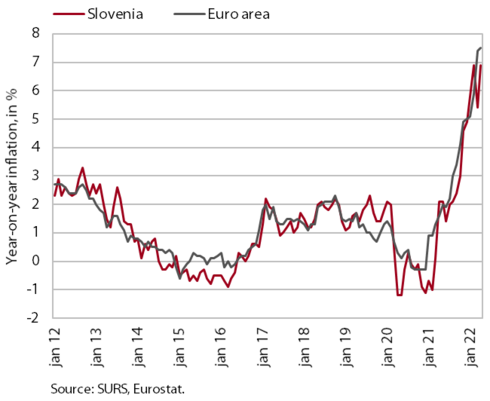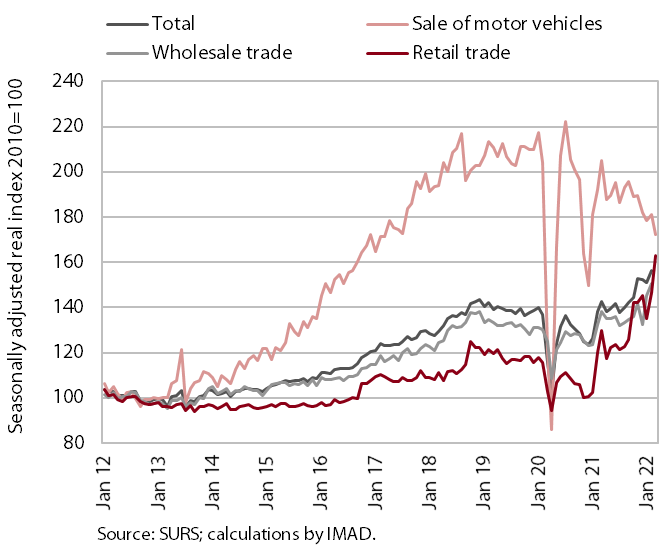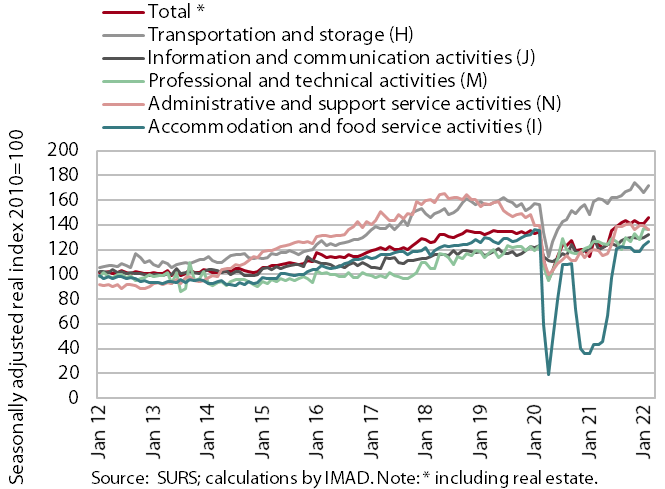Charts of the Week
Current economic trends from 25 to 29 April 2022: inflation, turnover in trade and turnover in market services
Inflation rose to 6.9% year-on-year in April. The high increase was mainly caused by high energy prices, especially petroleum product prices. In view of this, rising input prices and geopolitical uncertainties, prices of food and durable goods continued to grow at a robust pace, and service price growth also accelerated. Turnover in trade increased in February and the lifting of the recovered/vaccinated/tested rule is also estimated to have contributed to the positive developments in the retail trade in non-food products. After two months of decline, turnover in market services also increased in February in current terms and was also significantly higher year-on-year due to last year's low base. Compared to the same period before the epidemic, turnover was lower only in travel agencies.
Inflation, April 2022

Inflation rose sharply again in April to 6.9% year-on-year. The increase was largely due to energy prices, currently especially petroleum product prices, which rose by more than 30% year-on-year despite the current administered prices. Due to the temporary exemption from paying certain contributions, electricity prices fell by more than a fifth year-on-year. Compared to March, the year-on-year decline slowed considerably due to the high monthly increase (11.6%), as suppliers continued to pass on higher prices on wholesale markets to final customers. Amid high energy and input prices and geopolitical uncertainties, prices for food and non-alcoholic beverages continued to rise and were almost a tenth higher year-on-year. The largest price increases were for oils and fats, which were a fifth higher, and the price increase for bread and cereal products was also above average (13%). The year-on-year increase in durable goods prices in April was similar to previous months (8.8%). Growth in service prices, which hovered around 3% earlier this year, rose to 5% in April. This was mainly due to higher prices in recreation and culture, where prices of package holidays rose by about 8% in the face of high demand and were almost a fifth higher month-on-month. Prices also continued to rise in the restaurants and hotels group and in services related to housing.
Turnover in trade, February–March 2022

In February, turnover in trade increased after two months of decline. It was higher in all three main segments. The strongest growth was recorded in retail trade, whose dynamics in recent months was determined by strong fluctuations in real turnover in the sale of automotive fuels. After a sharp decline in January, it rose strongly in February and continued to increase in March, according to preliminary data. Following the lifting of the recovered/tested/vaccinated rule, retail trade in non-food products was also higher in February and March, while the sale of food, beverages and tobacco products remained at the level of the last quarter of last year. Turnover in wholesale trade continued to increase in February. After declining since October, turnover in the sale of motor vehicles also recovered slightly, but declined again in March, according to preliminary data, and still falls short of pre-epidemic turnover.
Turnover in market services, February 2022

In February, turnover in market services rose again after two months of decline. Compared to the previous month, total real turnover rose by 3.5%, while it increased by 17% year-on-year given the low base in February 2021. The strongest increase in turnover in current terms was in transportation and storage, where it had previously declined for two months, this time mainly due to strong growth in land transport. Turnover continued to grow in accommodation and food service activities and in information and communication activities, where the positive trend in the two main services (computer and telecommunications) continued. After high growth in the previous month, turnover declined slightly in professional and technical activities. Turnover also declined in administrative and support service activities, mainly due to lower turnover in employment services, where it had been increasing since December last year. The lag compared to turnover before the epidemic (February 2020) was only noticeable in travel agencies (by 48%).
